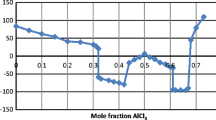Abstract
Lithium dicyanamide (LiN(CN)2) can trimerize, oligomerize, or polymerize through thermal treatment, and the product of this polymerization is dependent on both impurities and conditions of heating. We have thermally treated LiC2N3 containing small amounts of various additives such as halide, NaC2N3, LiCN, and other materials as pressed pellets under vacuum, and characterized the products by both solution and solid-state NMR, and by dielectric relaxation spectroscopy. Direct detection of 13C NMR spectra for the solid products was used to determine the relative amounts triazine and C≡N. The relative intensities and widths of the triazine peaks reflected variations in the reaction completion. We have also performed variable temperature 7Li NMR which is particularly useful for determining the correlation times and activation energies of the lithium ion motion in these materials as a function of preparation conditions and thermal history.
Graphical abstract





Similar content being viewed by others
Data availability
The datasets generated during and/or analyzed during the current study are available from the corresponding author on reasonable request.
References
A.P. Purdy, E. Houser, C.F. George, Lithium dicyanamide, its reactions with cyanuric chloride, and the crystal structures of LiN(CN)2(MeCN)2 and LiCN(C5H5N)2. Polyhedron 16(20), 3671–3679 (1997). https://doi.org/10.1016/S0277-5387(97)00097-1
B. Yancey, S. Vyazovkin, Venturing into kinetics and mechanism of nanoconfined solid-state reactions: trimerization of sodium dicyanamide in nanopores. Phys. Chem. Chem. Phys. 16(23), 11409–11416 (2014). https://doi.org/10.1039/C4CP01181C
Slichter, C.P., Principles of Magnetic Resonance. 3rd enl. and updated ed. Springer Series in Solid-State Sciences (Springer, Berlin, New York, 1996)
J.P. Yesinowski, Finding the true spin-lattice relaxation time for half-integral nuclei with non-zero quadrupole couplings. J. Magn. Reson. 252, 135–144 (2015). https://doi.org/10.1016/j.jmr.2014.12.012
N. Bloembergen, E.M. Purcell, R.V. Pound, Relaxation effects in nuclear magnetic resonance absorption. Phys. Rev. 73(7), 679–712 (1948). https://doi.org/10.1103/PhysRev.73.679
C.H. Kim, J.K. Park, W.J. Kim, Study on the ionic conductivity of polyether network polymer electrolytes: effect of the preparation method. Solid State Ionics 116(1–2), 53–61 (1999). https://doi.org/10.1016/S0167-2738(98)00339-7
M. Forsyth et al., An NMR investigation of ionic structure and mobility in plasticized solid polymer electrolytes. Electrochim. Acta 40(13–14), 2343–2347 (1995). https://doi.org/10.1016/0013-4686(95)00190-P
S. Wong, D.B. Zax, What do NMR linewidths tell us? Dynamics of alkali cations in a PEO-based nanocomposite polymer electrolyte. Electrochim. Acta 42(23–24), 3513–3518 (1997). https://doi.org/10.1016/S0013-4686(97)00040-6
J.D. Jeon, S.Y. Kwak, Variable-temperature Li-7 solid-state NMR investigation of Li-ion mobility and its correlation with conductivity in pore-filling polymer electrolytes for secondary batteries. Macromolecules 39(23), 8027–8034 (2006). https://doi.org/10.1021/ma061521v
J. Thielen et al., Multinuclear NMR study of structure and mobility in cyclic model lithium conducting systems. Appl. Magn. Reson. 45(10), 1063–1073 (2014). https://doi.org/10.1007/s00723-014-0588-5
N. Voigt, L. van Wullen, The mechanism of ionic transport in PAN-based solid polymer electrolytes. Solid State Ionics 208, 8–16 (2012). https://doi.org/10.1016/j.ssi.2011.11.031
A.S. Ulihin et al., Conductivity and NMR study of composite solid electrolytes based on lithium perchlorate. Solid State Ionics 179(27–32), 1740–1744 (2008). https://doi.org/10.1016/j.ssi.2008.02.027
Acknowledgments
Support for this research comes from the Office of Naval Research (ONR) through the base program NRL core funding.
Author information
Authors and Affiliations
Corresponding author
Ethics declarations
Conflict of interest
The authors declare that the research was conducted without any commercial or financial relationships that could be construed as a potential conflict of interest.
Rights and permissions
About this article
Cite this article
Klug, C.A., Fragiadakis, D.M. & Purdy, A.P. Lithium ion mobility in oligomerized and polymerized lithium dicyanamide. MRS Advances 7, 433–437 (2022). https://doi.org/10.1557/s43580-022-00249-8
Received:
Accepted:
Published:
Issue Date:
DOI: https://doi.org/10.1557/s43580-022-00249-8




